|
The Manufacturing Systems Engineering Unit (UESP) has
concluded, in December of 2005, the execution of the FATEC
project – Factory of High Technology for Footwear. According
to Luís Carneiro, UESP’s coordinator, “this was a great
project that fits in a line of continued performance and of
strategic importance of the Unit for the footwear sector”.
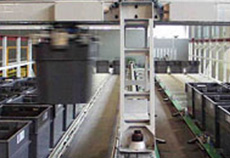 How
it all began... How
it all began...
UESP has developed a large continued activity in the
footwear sector in partnership with APICCAPS - Associação
Portuguesa dos Industriais de Calçado, Componentes, Artigos
de Pele e seus Sucedâneos (Shoemaking and components,
leather association), with CTC – Centro Tecnológico do
Calçado and with Lirel – Lima e Resende Lda.
These projects aimed at the development of innovative
systems and equipment, most of which related with the area
of internal logistics (automation of movement and storage of
the products in course of manufacture). The first project
was over in 1997 and its goal was the development of a
system for automation of the logistics associated with
footwear seam lines. Among the latest projects, we highlight
the European Euroshoe and Ciclope finished in 2003 and the
integrated European project CEC – Made-shoe, started in the
end of 2004.
 FATEC’s
importance FATEC’s
importance
FATEC project, started in July 2002 and finished in December
2005, was a key-instrument in this strategy. It was a
Mobilizing Project for the Technological Development, framed
in PRIME project, promoted by the Centro Tecnológico do
Calçado (Technologic Center for Footwear) and involving a
partnership of seventeen entities (four entities of the
scientific and technological system, five technology-based
companies and eight industrial footwear components and
tanning companies).
INESC Porto, together with Lirel, S.A., has participated
in the development of 20 new equipments/integrated systems
in six areas: equipment for small factories; automated
equipment; robotized factory of peer to peer plane assembly;
systems of logistics; tele-maintenance system and
operational management systems.
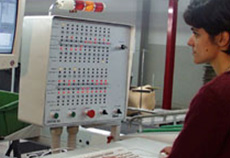 The
strategic objectives The
strategic objectives
The FATEC project is expected to be a contribution to go up
a step in the scale of complexity and sophistication,
investing in development of integrated and automatic
production line for the several subsectors of the shoe
course in view of the implementation of real industrial
units with the latest technology.
The integration of technologies, the robotization and
automation of the manufacturing operations, the elimination
of manual operations of movement and storage, the automatic
connection of the information systems of the companies
involved in the value chain, the peer to peer flexible
production and the creation of rules and common interfaces
among information and communication technology-based systems
were FATEC’s main objectives.
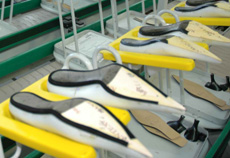 Main
sub-projects developed Main
sub-projects developed
System of
Transport and Peer to Peer Distribution
It is an innovative system of transport and peer to peer
distribution that follows every manufacturing stage. This
system is flexible enough to adapt to all the manufacturing
stages, which are very distinct. This adaptation is at the
level of the way the product is transported, as well as at
the level of the interface performed with the several
machines which are part of the process.
 The
current transport and distribution systems are not fit for
this philosophy of production of small series of a
sequential and continuous way. These systems are usually
adapted to each of the manufacturing stages and do not
follow the productive process along every manufacturing
stage. The
current transport and distribution systems are not fit for
this philosophy of production of small series of a
sequential and continuous way. These systems are usually
adapted to each of the manufacturing stages and do not
follow the productive process along every manufacturing
stage.
This system was conceived for the production of small
series and for small factories. It was installed in real
environment in the ZéCasal company, integrated with the
manufacturing cells and machines distributed by the
manufacturing process. It enables the creation of a buffer
in each staging point and it also makes it possible to skip
the work posts which are not being used, respecting the
performance range. It also includes a configuration of the
entry points of components along the manufacturing process
and a system of production control.
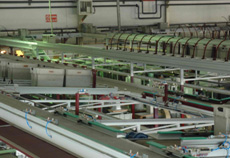 Internal
Logistics System Internal
Logistics System
Today, the area of the companies’ internal logistics is,
generally, the one which has been less developed. UESP’s
coordinator states: “If we take a minute to watch the
everyday life of the companies’ factories, we observe the
existence of a chaotic dynamics of people, materials and
products”.
Luis Carneiro asserts: “And if, on the other hand, we
analyse the causes of these moves, then we will easily
observe that this is mainly due to the increasing difficulty
in implementing organisational processes and more consistent
procedures that allow the operators to thoroughly organise
the production plans, given the growing volumes of small
orders, of distinct models that characterise the footwear
sector or other fashion-related ones.”
The system developed and installed in the Codizo company
is made of an automatic system of intermediate storage of
the product in course of manufacture for each one of the
company’s sections. This storage system is divided into four
warehouses with a full capacity of 10.500 pairs. It is an
automatic transport system made of a vast network of
conveyors and towers that perform the interface between the
warehouses and the six manufacturing sections.
 All
this internal logistics system is managed by a complex
computer system and automation developed by INESC Porto. The
management of the assembly sections and the elaboration of
production routes is a responsibility of the module of
operational management. All
this internal logistics system is managed by a complex
computer system and automation developed by INESC Porto. The
management of the assembly sections and the elaboration of
production routes is a responsibility of the module of
operational management.
This module allows operators to optimise, in an intuitive
way, the production of each one of the manufacturing
sections and automatically determine the best route for each
one of the boxes of the production orders. Reflecting on the
planning decisions in the factories is now immediate,
allowing for a better use of all the resources available
reducing the time spent in production orders and for more
respect for the deadlines agreed with the clients.
 System
of Storage and Expedition of the Finished Product System
of Storage and Expedition of the Finished Product
This system, developed by INESC Porto, overcomes the regular
warehouse management operations, interacting with all the
departments that deal with the finished product and with the
clients.
Based on an interface with a great detail level with ERP,
this system allows for the reception and association of
tariffs to pallets using code bars issued by the company. It
also contains an elaborate heuristic that considers several
factors, from among which we stand out client, deadlines,
the types of product and the results of the quality control.
It also suggests places in the warehouse for shoe storage.
Using a friendly interface, this management system allows
the client to check what is in store, when their orders are
expected to be finished and if they can select the packages
to be sent per week. The department of export receives the
request and sends it to the warehouse. In this department,
the system reduced substantially the operations to be
performed.
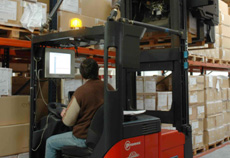 The
stacking operators receive their preparation, boarding and
picking orders through a computer, connected to a wireless
net, placed on the stacker. All the movements are validated
by an RFID system installed in the warehouse cells. The
stacking operators receive their preparation, boarding and
picking orders through a computer, connected to a wireless
net, placed on the stacker. All the movements are validated
by an RFID system installed in the warehouse cells.
The picking operation, which, in the old days, had the
wrong tariffs sent to the client, is now aided by this
system that, through wireless players and a luminous panel,
validates the tariff’s picking in the pallet, eliminating
the errors in handling.
This system validates if the tariffs that leave the
warehouse belong to the boarding. All the departments of the
company that deal with the finished product (quality,
export, marketing and warehouse) are now interconnected by
this system, enabling a harmonious interconnection with
immediate reflex in the processes and its decisions. The
company soon became aware of the benefits of this system
and, in a few months, it increased the storage capacity up
to 201.600 pairs.
We should also highlight that all the papers used in the
warehouse and between the several departments have been
eliminated. The interface with the company’s ERP renders the
process of issuing of bills automatic and immediate,
replacing the old one which was subject to errors and took
hours.
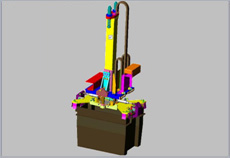 Remote
Maintenance System Remote
Maintenance System
Telemaint is a remote maintenance system that will allow the
equipment suppliers to guarantee a permanent maintenance of
the equipment installed in the several clients, making it
possible to, in case of breakdown, identify the problem
right away and solve it much more quickly and with much less
costs.
Through specific software, the supplying company monitors
the state of the machine, allowing it to develop the online
maintenance procedures, such as: software updates and
software damage repair, early identification of possible
breakdowns enabling an intervention on time, early and
thorough identification of the problems and the cause of the
breakdown, so that the technician can bring all the
necessary components when the equipment requires
intervention.
The functionalities of the maintenance management, alarm
management, document management, technical assistance
management and periodical evaluation allow the supplying
companies to perform next to their clients with higher
quality level.
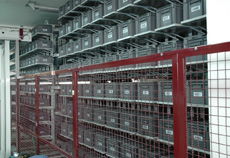 System
of Storage of Samples and Prototypes System
of Storage of Samples and Prototypes
The warehouse installed in the Calafe company enables the
storage of samples and prototypes, including lasts, cutters,
molds or other tools in a relatively small space. Besides
saving space, the system makes it possible to organise the
folder of the manufacture of new products and samples,
including lasts, cutters or other necessary tools, which
become available online.
Whenever the company needs the elements of manufacture of
a product, even if it has not been manufactured in many
years, all they have to do is research in the system and
select the product desired. By then, the system will
automatically get the respective container from the
warehouse and give it to the user.
 In Calafe’s case, the system enables the storage of 1150
containers in a room of around
60 mē, which should be able to store 3000 samples, the
equivalent to three and a half years of activity. In Calafe’s case, the system enables the storage of 1150
containers in a room of around
60 mē, which should be able to store 3000 samples, the
equivalent to three and a half years of activity.
INESC Porto’s team
Rui Rebelo led UESP’s group which developed these
sub-projects. Paulo Sá Marques, Luís Guardão, Pedro Ribeiro,
Luís Lima, Fernando Guedes, Paula Silva, Jorge Pereira,
Daniel Machado and Luís Carneiro were also a part of this
team
<< Previous
| Next >>
|


 How
it all began...
How
it all began... FATEC’s
importance
FATEC’s
importance The
strategic objectives
The
strategic objectives Main
sub-projects developed
Main
sub-projects developed The
current transport and distribution systems are not fit for
this philosophy of production of small series of a
sequential and continuous way. These systems are usually
adapted to each of the manufacturing stages and do not
follow the productive process along every manufacturing
stage.
The
current transport and distribution systems are not fit for
this philosophy of production of small series of a
sequential and continuous way. These systems are usually
adapted to each of the manufacturing stages and do not
follow the productive process along every manufacturing
stage.  Internal
Logistics System
Internal
Logistics System  All
this internal logistics system is managed by a complex
computer system and automation developed by INESC Porto. The
management of the assembly sections and the elaboration of
production routes is a responsibility of the module of
operational management.
All
this internal logistics system is managed by a complex
computer system and automation developed by INESC Porto. The
management of the assembly sections and the elaboration of
production routes is a responsibility of the module of
operational management.  System
of Storage and Expedition of the Finished Product
System
of Storage and Expedition of the Finished Product The
stacking operators receive their preparation, boarding and
picking orders through a computer, connected to a wireless
net, placed on the stacker. All the movements are validated
by an RFID system installed in the warehouse cells.
The
stacking operators receive their preparation, boarding and
picking orders through a computer, connected to a wireless
net, placed on the stacker. All the movements are validated
by an RFID system installed in the warehouse cells. Remote
Maintenance System
Remote
Maintenance System  System
of Storage of Samples and Prototypes
System
of Storage of Samples and Prototypes In Calafe’s case, the system enables the storage of 1150
containers in a room of around
60 mē, which should be able to store 3000 samples, the
equivalent to three and a half years of activity.
In Calafe’s case, the system enables the storage of 1150
containers in a room of around
60 mē, which should be able to store 3000 samples, the
equivalent to three and a half years of activity.